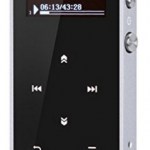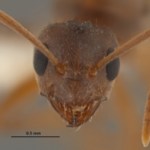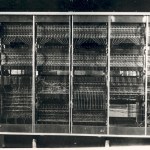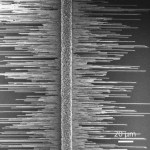electronics
Several weeks ago I tried once again, after many prior ill fated attempts over several years, to get a device that would play music, audio books, and be a radio. The audiobook part wasn't the most important part, but the ability to play various audio files AND act as a radio AND not be a big giant thing I had to strap to a body part AND be sturdy were all important. This latest attempt has gone very well, and I now have a device that is very nice and therefore, I figured you'd want one too.
This time I tried the AGPtEK M20S 8GB Mini MP3 Player(Expandable Up to 64GB), Lossless Sound Touch…
Crazy ant image by Joe A. MacGown with the Mississippi Entomological Museum
Tawny (or Raspberry) crazy ants (Nylanderia fulva) are an invasive ant species from South America that have been invading the United States. For some reason, the ants are attracted to electronics and have been responsible for the destruction of numerous electronic devices.
A new study shows that tawny crazy ants rub formic acid over their bodies as a shield against fire ant venom. This conclusion came after researchers observed the ants rubbing themselves with formic acid after a confrontation with fire ants (…
Since the haiku post was well received, and since we have another three pieces online today – each on a different finding and each interesting in its own right – I have decided to return to the haiku format. Among other things, there is something quite satisfying about distilling complex scientific findings down to 17 little syllables – like writing the perfect tweet, but more so.
In any case, follow the links to read more:
A burst of enzymes:
A transcription traffic jam
Watch for gene speed bumps
Genetics can rid
The poison from potatoes
Or add it elsewhere
image: Thinkstock…
Google's official blog has a post today on the first computer in Israel: WEIZAC, built at the Weizmann Institute in the 1950s. Prof. Aviezri Frenkel gives a charming description of the project, including the fireworks when the machine was first turned on, in the presence of the VIPS who had come to see the new wonder.
http://googleblog.blogspot.co.il/2013/06/remembering-weizac-beginning-of.html
The foresight of the scientists who decided to build the computer is mentioned. But we can also thank them for their foresight in preserving this piece of computing history once newer computers…
A recent study by Prof. Ernesto Joselevich and his team, published in Science, features perfectly aligned horizontal arrays of thin, millimeter-long nanowires. We spoke with Joselevich recently to find out why he and others in the field are excited by this advance:
WSW: Your lab has produced a fair amount of innovative research in recent years. Why is this one special?
EJ: First of all, we succeeded in growing very long horizontal nanowires with exquisite control over their orientation. Because of the numerous potential uses for semiconductor nanowires, there is a lot of competition to…
by Elizabeth Grossman
Far-reaching and ambitious recommendations laid out at a meeting of the United Nations Strategic Approach to International Chemical Management (SAICM) could significantly reduce occupational exposure to hazardous chemicals in the electronics industry - and do so at every stage of product life, from component design and manufacturing to recycling. If implemented, these recommendations would reduce health hazards for the thousands of workers employed at electronics production plants worldwide and begin to reduce environmental health hazards for those involved in…
Last week's series of posts on the hardware needed for laser cooling and trapping experiments dealt specifically with laser-cooling type experiments. It's possible, though, to make cold atoms without using laser cooling, using a number of techniques I described in two posts back in January. Those didn't go into the hardware required, though, so what's different about those techniques in terms of the gear?
Less than you might think. In fact, most of the labs that do these experiments use exactly the same sorts of equipment that laser coolers do. Including some lasers.
It's not all of them, but…
The third category in our look at lab apparatus, after vacuum hardware and lasers and optics is the huge collection of electronic gear that we use to control the experiments. I'll borrow the sales term "test and measurement" as a catch-all description, though this is really broader than what you'll usually find in that category.
This category covers all sorts of stuff, from power supplies to data acquisition equipment, but we'll start with the oscilloscopes.
The picture above shows two of the many oscilloscopes that rattle around my lab. These are used for almost everything that involves a…
You know the old adage "The camera adds 10 pounds?" Well, I'm not sure if thats true or not (I think its bunk), but HP has recently released cameras with a feature to help knock off those extra pounds. I found it rather absurd, as the slimming feature is really only a vertical distortion of the entire picture which gives the subjects a rather pointy-looking head. Um, hasn't anyone heard of Photoshop if they really want to mess with reality?
But really, this highlights to me a growing (but not new) awareness of products which cater to vanity. Are the days gone when photographs captured the…
Ever wonder how plasma TV's work? Well, I did, and decided to figure it out!
"Traditional" televisions use cathode ray tubes, in which a gun fires a beam of electrons inside a large glass tube at phosphor atoms at the other end. The electrons excite the phosphor atoms, causing them to light up as pixels. The image is produces by lighting up different areas of the phosphor coating with different colors (red, green, blue) at varying intensities. While this sort of TV produces nice images, physically they are bulky. In order to increase screen size, you have to increase the length of the…




